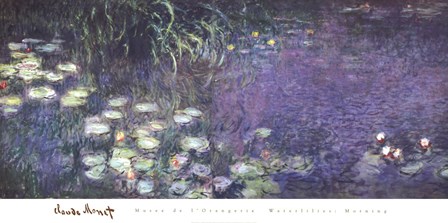
Bring sunshine into your home with Claude Monet's clear, airy paintings of natural subjects.
Nature, and the clear beauty that changes in sunlight bring to everyday scenes, are main elements in Monet’s unique style. “I am following Nature without being able to grasp her…I perhaps owe having become a painter to flowers,” he once wrote. His fascination with capturing sunlight’s nuances led him to found the Impressionist art movement, which takes its name from his painting, Impression, Sunrise.
On a visit to the Louvre as a young painter, Monet saw other art students faithfully copying the Old Masters. Instead of joining their ranks, he set his art supplies up by a window and tried to capture what he saw outside.
“For me, a landscape does not exist in its own right, since its appearance changes at every moment; but the surrounding atmosphere brings it to life--the light and the air which vary continually. For me, it is only the surrounding atmosphere which gives subjects their true value.”
Monet's deep understanding of natural light channels a feeling of sunshine through his images, transforming even a windowless room. In his painting, Madame Monet and Her Son, the warmth of the sunshine beaming down on the lady’s parasol, and the love he felt for his wife and child, transcend the canvas.
Many of his paintings pull the viewer into a natural landscape, using paths and other metaphors to create this illusion. In Garden at Giverny, leaves’ shadows dapple a path through a sunny garden, and entice the viewer into a mid-morning stroll through flowers, trees, and his or her own imagination. The painting Beach at Trouville uses a boardwalk to invite the viewer in, this time for a seaside promenade and a lingering feeling of being on holiday.
As in the previous painting, the play of light on water fascinated Monet, and his many works featuring ponds, lakes, rivers and the sea illustrate this career-long interest. Antibes, showing a lone, wind-bent tree on the shore, is at once charming and melancholy. Water Lily Pond, on the other hand, is as full of cheer as it is of color. Cliff Walk at Pourville, on the other hand, is a postcard from another time, a snapshot of a sunny day along the coast.
To view more of Claude Monet's masterful works of art featuring light and shade, reflection and emotion, visit www.fulcrumgallery.com.

